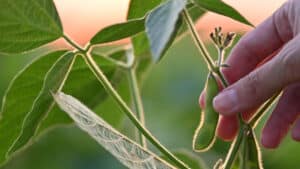With spring on the horizon, it’s important to keep stewardship at the top of the mind when planting.
Spring on the farm brings new beginnings and new opportunities. This year, a new stewardship campaign encourages farmers to start their spring planting by taking a fresh look at best practices for using treated seed.
“Farmers have been using seed treatments to protect seeds and seedlings for a number of years,” says Shawn Potter, head of product marketing at Syngenta Seedcare. “One of the things we’ve realized is that as we talk about the benefits of those seed treatments, we also need to talk about proper stewardship and best practices.
“They go hand in hand, and this campaign just brings a fresh awareness to many of the things farmers have already been doing, but that can always be a good reminder as we begin a new planting season.”
The BeSure! campaign was created in partnership with the Growing Matters coalition, led by Syngenta, Bayer Crop Science, Valent U.S.A., and Mitsui Chemical Agro. The American Seed Trade Association (ASTA) and the National Pesticide Safety Education Center (NPSEC) are also involved.
“It’s truly a coalition effort, and the reason is that we all share a common goal. Stewardship is important for all of us,” says Dan Fay, Valent U.S.A.’s senior manager, technology operations and stewardship lead.

The goal of BeSure! is to strengthen awareness of stewardship best practices to protect bees and other wildlife during the handling, planting and disposal of treated seeds.
Nick Tinsley, SeedGrowth technical service representative with Bayer, says the goal is not to add a lot of extra steps to spring planting, but rather to do what farmers are already doing in a way that reflects the most up-to-date research on stewardship.
Farmers can visit GrowingMatters.org for tips, reminders, and other information.
“As we think about planting in 2019, we want to remind farmers and applicators that there are best management practices when it comes to dealing with these products,” Tinsley says. “Being a good steward doesn’t have to be complicated. It’s just about being mindful of these practices.”
Steps Toward Stewardship
Step No. 1: Read the label.
“We put that No. 1 on the list because it’s really where it all starts,” Fay says.
Potter agrees, adding that the label changes fairly often with regards to targeted pests and application rates. While much of the information does remain the same from year to year, especially on the smaller bag tag, it can be tempting to think it’s unnecessary to read the tag again. However, it’s still worth reviewing.
“Human nature says, ‘I’ve done this a few times so I can figure it out,’ but bags do have the PPE [personal protective equipment] information on there for their own safety, and their workers’ safety. It’s a very quick thing to look at and review,” Potter says.
Flowers and Fields
Another important step toward stewardship is to eliminate flowering weeds near the fields where treated seed will be planted.
“A lot of people haven’t thought as much about that, but if we want to limit potential exposure for pollinators, that’s an important step,” Potter says.

“We understand that an important part of the seed treatment is the insecticide component which protects that seed in the ground. And we know that it could present a risk to bees and other pollinators if we don’t take the necessary steps to reduce exposure,” Tinsley says.
Potter says that depending on what is flowering nearby, a quick pass with a mower can make a big difference.
“Usually, the best recommendation is to simply mow the weeds around the edges of a field before planting,” he says.
Communication with local beekeepers is also important. Sometimes it’s as simple as reaching out to a neighbor who has hives. Other times, farmers can search state or local bee registries to find out where the nearest hives are.
“It helps to know where we need to be extra mindful. It’s part of being a good steward and a good neighbor,” Tinsley says.
Lubricate for Less Dust
The BeSure! campaign also directs farmers to use proper seed lubricants to reduce any potential for dust-off when working with treated seed.
“Syngenta focuses on using formulations with polymers and sticking agents to ensure the treatment stays on the seed and ends up where we need it to be, in the ground,” Potter says. “However, seed-on-seed abrasion can occur as the seeds are handled, so working with retailers to use the recommended lubricant is an important step toward increased stewardship.”
“Again, this isn’t a huge time commitment at an already-busy planting time. It’s simply an additional product to add when they are filling up the planter,” he says.
Planning for Pollinators
Farmers and applicators also need to be mindful of spills, as well as cleaning out the planter in a non-sensitive area.
“If there are flowering plants or water sources nearby, that’s not a good place. Just be mindful of what you are doing and make those small changes to increase stewardship,” Tinsley says.
Similarly, Potter says it is important to properly dispose of leftover seed.
“We don’t want to see that treated seed enter into the food system, so we need to properly clean out planters and dispose of or bury any seed so wildlife can’t get to it,” Potter says.
“Farmers consider themselves stewards of their land, so while spilling a few seeds might not seem like a large issue, once they are aware that it could harm birds or other animals, they won’t want to knowingly contribute to that problem,” Fay says. “If done right away, it should take very little time to make a seed spill is cleaned.”
Responsibility Over Restrictions
Farmers understand the value seed treatments provide. While spring is a busy time, it’s also an important time to remember that without the necessary steps toward better stewardship, these treatments could be at risk.
“The products we’re talking about are extremely valuable and there is a lot of information out there on how to use them safely,” Fay says. “We want to remind farmers and applicators that applying these known best practices will help make sure these tools will be around for a long time.”
The BeSure! campaign is not about adding new things for farmers to do, but rather it’s about reminding them things that are important.
“It only takes 5-10 minutes to create a lot of positives in the industry,” Potter says.

“In most cases, it’s been 11 months since they have handled these products so it’s good to have a refresher,” Tinsley says.
Fay said no one wants more regulations or restrictions.
“Farmers understand that it’s better for them to be in charge of stewardship by following these best practices,” he says. “It’s very important that we work together to make sure these products are always used safely and responsibly.”
Tinsley agrees.
“It doesn’t have to be complicated to be a good steward.”











